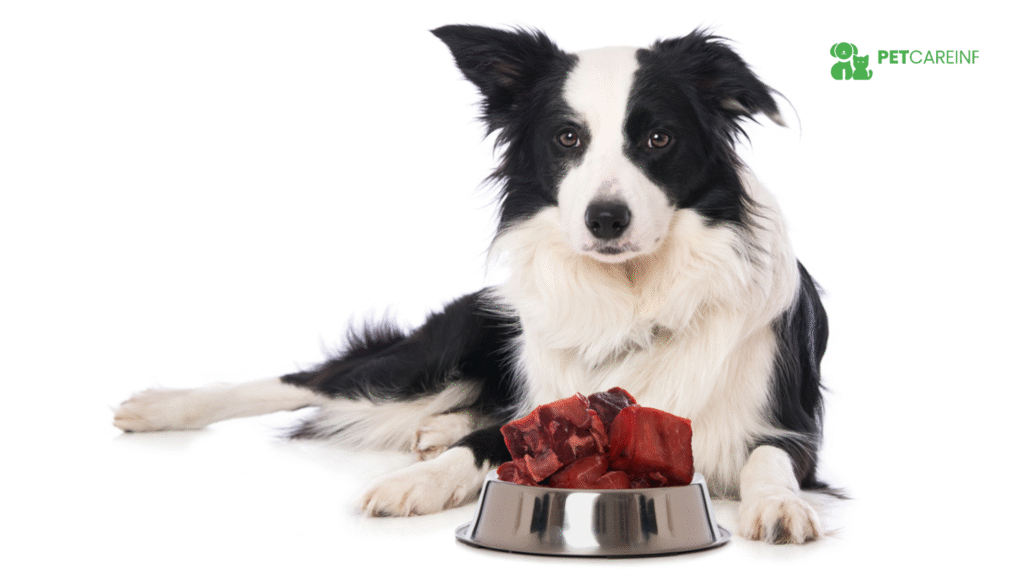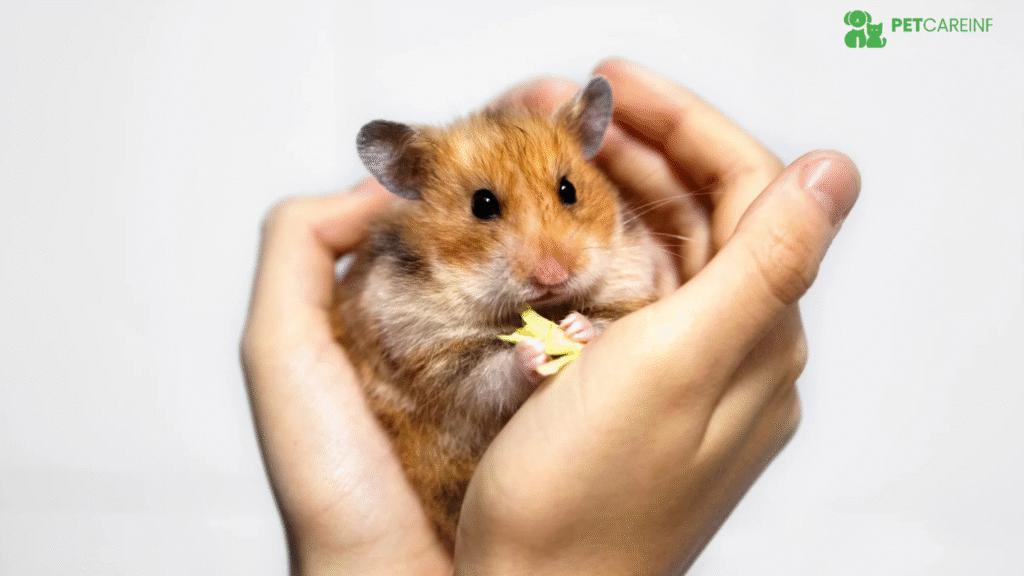- How to Decide What’s the Best Food for a Dog (Framework You Can Reuse)
- Dry vs. Wet vs. “Fresh” vs. Raw: What’s Best?
- Reading Labels Like a Pro (So “What’s Best” Isn’t a Guess)
- How to Transition to a New Food Without Drama
- When Dental Care Belongs in the Food Conversation
- Top 07 Best Dog Food & Dental Care Products for 2025
- Quick Picks by Scenario (So You Don’t Overthink It)
- How to Tell If a Food Is Actually Working
- Smart Add-Ons That Actually Help
- What About Grain-Free vs. With Grains?
- Budget & Availability: A Real-World Note
- Final Thought
- Frequently Asked Questions
When you’re staring at a wall of kibble bags and cans, it’s normal to ask, “dog food which is best?” The truth: the best dog food for dogs isn’t one brand for everyone, it’s the food that matches your dog’s age, size, health, and daily routine.
In this guide, we’ll turn marketing noise into practical steps. You’ll learn how to read labels, why AAFCO matters, how to switch foods without tummy trouble, and when add-ons like probiotics and dental chews make sense. Finally, we’ll share 10 trusted options you can confidently try today.
How to Decide What’s the Best Food for a Dog (Framework You Can Reuse)
Choosing the best dog dog food follows a simple pyramid: health needs → life stage & size → ingredients & analysis → brand quality → your dog’s enjoyment.
Health comes first
Start with a quick checklist: Does your dog have food sensitivities (itching, ear gunk, soft stool), a sensitive stomach, weight issues, joint needs, or a vet-diagnosed condition? These answers narrow choices fast. For example, a sensitive gut may benefit from salmon-based formulas with probiotics; a large-breed puppy needs controlled calcium/phosphorus.
Life stage & size matter
- Puppy (especially large breed): needs DHA for brain/vision and careful mineral balance for bones.
- Adult: maintain lean muscle, stable energy, healthy skin and coat.
- Senior: support joints, immune function, and ideal body weight.
Size matters too; smaller kibble can help small breeds chew well, while large breeds often prefer bigger pieces or specific large-breed formulas.
Ingredients & guaranteed analysis
Ingredients tell you what, the analysis tells you how much. Look for named protein (e.g., salmon, chicken) high on the list, and check fat and fiber for your dog’s needs. For coat health, foods with salmon oil or flaxseed (omega-3s) are a plus. For digestion, prebiotics and probiotics help.
The AAFCO nutritional adequacy statement
On the label, find the sentence referencing AAFCO. It should say the food is “complete and balanced” for a specific life stage (growth, adult, all life stages). This is your minimum quality gate.
Brand quality and transparency
Consider where it’s made, whether nutritionists are involved, and if recipes list purposeful ingredients (not just filler). Then: does your dog actually thrive on it? The best formula is the one that agrees with your dog over weeks, not just days.


Dry vs. Wet vs. “Fresh” vs. Raw: What’s Best?
Kibble (dry food) is convenient, cost-effective, and easy to store. It’s common to ask “dog best food — is it always kibble?” Not necessarily, but high-quality dry foods can be excellent for most healthy dogs.
- Wet/canned boosts palatability and hydration. Great for picky eaters and seniors.
- Fresh/frozen or gently cooked can be highly digestible and palatable, but pricier and storage-heavier.
- Raw diets are debated; they may be palatable but can carry handling and pathogen risks if not produced or managed correctly. If you’re curious, discuss raw or raw-adjacent options with your veterinarian.
- Balanced approach: many families feed quality kibble as the base and add wet or fresh toppers for variety, moisture, and enrichment.
Reading Labels Like a Pro (So “What’s Best” Isn’t a Guess)
Quick label hits:
- Look for named animal proteins early in the list (e.g., salmon, not “meat by-product” as the only protein).
- Scan for omega-3 sources (salmon oil, flaxseed) for skin/coat.
- Favor digestive supports like prebiotics (chicory root, beet pulp) and probiotics (Lactobacillus, Enterococcus).
- Verify the AAFCO statement matches your dog’s life stage.
- Choose transparent brands that disclose where and how foods are made.
- Avoid jumping foods often; give your dog time to adapt before judging results.
How to Transition to a New Food Without Drama
Gastro-upset is usually about speed. Use a 7–10 day ramp:
7-Day Transition Plan
- Days 1–2: 75% old food, 25% new.
- Days 3–4: 50/50 split.
- Days 5–6: 25% old, 75% new.
- Day 7+: 100% new food.
If your pup has a very sensitive stomach, extend to 10–14 days. Add a spoonful of plain pumpkin or a probiotic if stools soften during the switch.
When Dental Care Belongs in the Food Conversation
Food choice isn’t the only factor in overall wellness. Dental health is central to comfort, longevity, and even heart health. Daily brushing is the gold standard, but most households need realistic tools, too.
That’s where dental chews with functional textures and toothpaste centers can help reduce plaque and tartar between brushings, and keep breath pleasant.
Top 07 Best Dog Food & Dental Care Products for 2025
These trusted brands combine nutrition, flavor, and quality ingredients to help you choose the best dog food for a dog, whether you’re feeding a puppy, adult, or senior.
1) Ark Naturals Brushless Toothpaste – Medium Breeds (18oz, 2-Pack)
Vet-formulated dental chews that clean teeth while your dog chews. The 4-in-1 design fights plaque, polishes enamel, and freshens breath naturally with cinnamon and alfalfa.
Highlights: Toothpaste-filled center; no corn/soy/preservatives; helps reduce plaque/tartar; made in the USA.


2) Wag Dry Dog Food – Salmon & Sweet Potato (24 lb)
Grain-free, high-protein recipe with real salmon as the first ingredient. Balanced omegas and digestion-friendly fibers support skin, coat, and gut health.
Highlights: Real salmon; no added corn/wheat/artificial colors; formulated with vets and nutritionists.


3) NutriSource Seafood Select Grain-Free Dog Food (26 lb)
Salmon and menhaden fishmeal deliver rich omega-3s; includes pro- and prebiotics for gut support. Suits sensitive dogs who do well on fish proteins.
Highlights: Digestive support; balanced fatty acids; grain-free; all-life-stages.
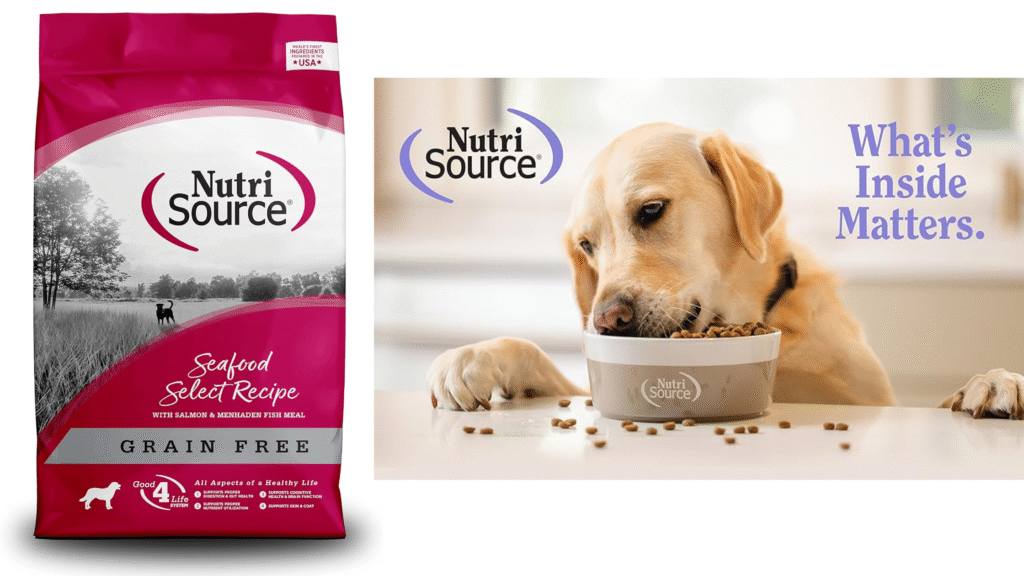

4) Purina Pro Plan High Protein Puppy – Chicken & Rice (18 lb)
Puppy-specific formula with DHA from fish oil for brain/vision, plus minerals for bones and teeth. Great everyday choice for growth.
Highlights: Real chicken; DHA for development; no artificial colors or flavors; breeder/vet trusted.


5) IAMS Proactive Health Minichunks Adult – Chicken (30 lb)
Complete, balanced nutrition with antioxidants for immunity, omega-6s for skin/coat, and a kibble size many dogs love.
Highlights: Digestive fiber + prebiotics; heart and immune support; visible coat benefits.


6) Purina ONE Chicken & Rice Formula – Dry (31.1 lb)
A SmartBlend approach focusing on strong muscles, coat health, and joint support. Palatable and widely available.
Highlights: Real chicken first; prebiotic fiber; natural glucosamine; complete & balanced.
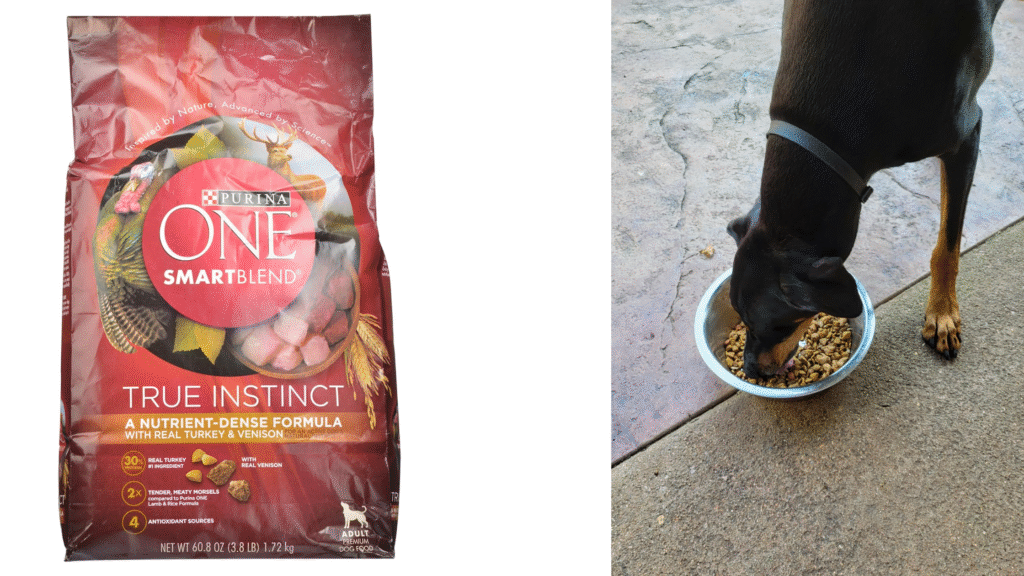

7) Nature’s Recipe Grain-Free Wet Variety Pack (12 × 2.75 oz)
Three grain-free recipes featuring real chicken in savory broth. Handy single-serves for toppers or small meals — excellent for picky eaters.
Highlights: No corn/wheat/soy or artificial flavors; balanced with vitamins; easy portioning.
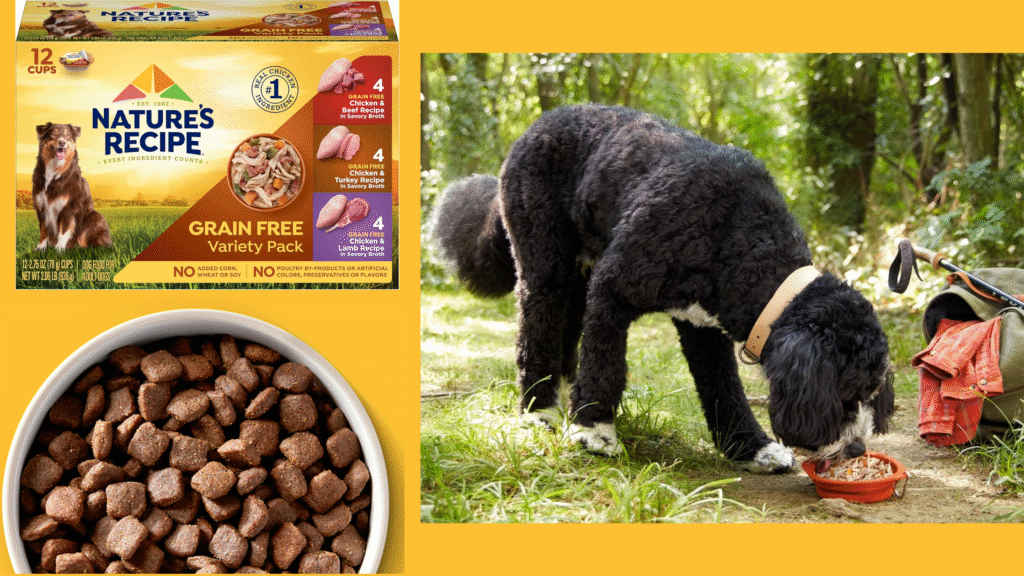

Quick Picks by Scenario (So You Don’t Overthink It)
- “My puppy needs a solid start.” Try Purina Pro Plan Puppy Chicken & Rice for DHA, protein, and trusted growth support.
- “Sensitive stomach + itchy skin.” Consider fish-forward, gut-friendly recipes like NutriSource Seafood Select or Wag Salmon & Sweet Potato (watch stool and coat over 3–4 weeks).
- “I want convenient moisture for a picky eater.” Use Nature’s Recipe Grain-Free Wet Variety as a topper over quality kibble to boost palatability and hydration.
- “Breath & tartar are getting rough.” Pair daily toothbrushing with Ark Naturals Brushless Toothpaste sized to your dog (mini, small/soft, medium, large/extreme).
- “All-around adult maintenance with good value.” IAMS Minichunks Adult delivers balanced nutrition, digestion support, and coat benefits many owners notice.
- “I need everyday availability.” Purina ONE Chicken & Rice is widely stocked and easy to integrate with wet toppers.
How to Tell If a Food Is Actually Working
Give any new diet 3–4 weeks before you judge. Track:
- Stool quality: formed, easy to pick up, not overly frequent.
- Coat & skin: shine, reduced dander/itch, minimal hot spots.
- Energy & weight: steady energy, visible waist, ribs palpable with light pressure.
- Breath & teeth: diet alone won’t fix dental issues, but better nutrition and dental chews help.
If your dog backslides (soft stool, itch, low energy) after week 2, slow the transition or consult your vet for a targeted plan.
Smart Add-Ons That Actually Help
- Probiotics & prebiotics: great during transitions or after antibiotics.
- Omega-3s (EPA/DHA): for skin, coat, joints. Look for foods already containing salmon oil or add a vetted fish-oil supplement.
- Dental routine: daily brushing + functional chews (like Ark Naturals Brushless sized correctly).
- Meal rhythm: 2 set meals per day for adults; measured portions prevent overfeeding.
What About Grain-Free vs. With Grains?
Both can be appropriate. Some dogs do best on grain-inclusive diets (e.g., rice, oats) while others thrive grain-free (e.g., sweet potato, peas).
If you’re unsure, start with a well-balanced, complete & balanced formula your vet is comfortable with and evaluate results. The “best food for a dog” is the one that maintains great stools, skin/coat, energy, and weight — regardless of grain status.
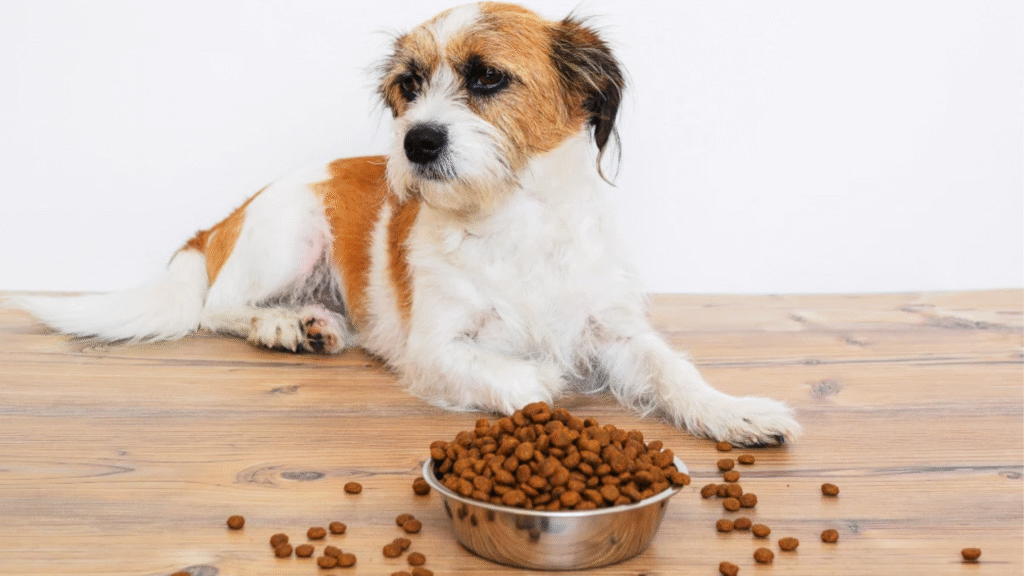

Budget & Availability: A Real-World Note
The perfect diet on paper isn’t useful if it’s impossible to buy or blows your budget. Part of answering “dog food which is best” is consistency.
It’s better to feed a solid, accessible food every day than to rotate through frequent “out of stock” boutique recipes. Options like IAMS, Purina ONE, and Purina Pro Plan are widely available; NutriSource and Wag offer strong value in their niches.
Final Thought
For what’s the best food for a dog, start with a complete & balanced formula aligned to your dog’s life stage and needs, transition slowly, and measure outcomes you can see: stools, skin/coat, energy, weight, and breath. Then stay consistent.
If you want, I can tailor a personal feeding plan: tell me your dog’s age, breed/size, weight, activity level, known sensitivities, and your budget. I’ll shortlist 3–5 ideal formulas and a transition schedule you can start today.
Frequently Asked Questions
Which brand of dog food is the best?
The best brand depends on your dog’s age, health, and taste. Brands like Purina Pro Plan, IAMS, NutriSource, and Wag are widely trusted because they use balanced ingredients, vet-backed formulas, and maintain AAFCO standards for complete nutrition.
Which is the best food to feed your dog?
The best food for a dog is one that keeps their weight stable, coat shiny, and stools firm. Look for recipes with real meat, digestible grains or vegetables, and omega fats. Foods like NutriSource Seafood Select or Wag Salmon & Sweet Potato fit these needs for most adult dogs.
Which is the No. 1 dog food?
There’s no single “No.1 dog food” for all breeds, but Purina Pro Plan often tops vet lists for quality, consistency, and results. It’s backed by years of nutrition science and works well for both puppies and adult dogs across all sizes.
What is the healthiest food for a dog?
The healthiest food for a dog includes high-quality animal protein, natural fats, and a balanced mix of vitamins and minerals. Options like Purina ONE Chicken & Rice or IAMS Proactive Health support digestion, coat, and energy while avoiding fillers or artificial colors.
Is it okay to mix dry and wet dog food?
Yes. Mixing dry and wet food adds variety, flavor, and moisture to your dog’s diet. Just make sure the combined amount meets their daily calorie needs. Many owners use a scoop of Nature’s Recipe Grain-Free Wet Food as a topper for kibble.

